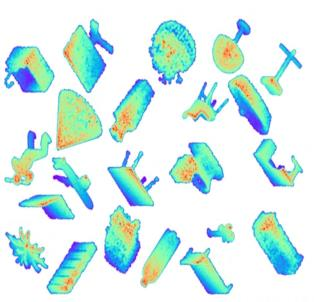The rapid development of artificial intelligence together with the powerful computation capabilities of the advanced edge servers make it possible to deploy learning tasks at the wireless network edge, which is dubbed as edge intelligence (EI). The communication bottleneck between the data resource and the server results in deteriorated learning performance as well as tremendous energy consumption. To tackle this challenge, we explore a new paradigm called learning-and-energy-efficient (LEE) EI, which simultaneously maximizes the learning accuracies and energy efficiencies of multiple tasks via data partition and rate control. Mathematically, this results in a multi-objective optimization problem. Moreover, the continuous varying rates over the whole transmission duration introduce infinite variables. To solve this complex problem, we consider the case with infinite server buffer capacity and one-shot data arrival at sensor. First, the number of variables are reduced to a finite level by exploiting the optimality of constant-rate transmission in each epoch. Second, the optimal solution is found by applying stratified sequencing or objectives merging. By assuming higher priority of learning efficiency in stratified sequencing, the closed form of optimal data partition is derived by the Lagrange method, while the optimal rate control is proved to have the structure of directional water filling (DWF), based on which a string-pulling (SP) algorithm is proposed to obtain the numerical values. The DWF structure of rate control is also proved to be optimal in objectives merging via weighted summation. By exploiting the optimal rate changing properties, the SP algorithm is further extended to account for the cases with limited server buffer capacity or bursty data arrival at sensor. The performance of the proposed design is examined by extensive experiments based on public datasets.
翻译:人工智能的迅速发展,加上先进的边缘服务器的强大计算能力,使得有可能在无线网络边缘部署学习任务,这种网络边缘被称为边缘智能。数据资源与服务器之间的通信瓶颈导致学习性能下降,耗能巨大。为了应对这一挑战,我们探索了一种新的模式,称为学习节能(LEE) EI,它同时通过数据分区和速率控制使多项任务的学习便利度和能效最大化。从数学角度讲,这导致多目标优化问题。此外,整个传输期限的持续不同速度引入了无限变量。为了解决这一复杂问题,我们考虑数据资源与服务器之间的通信瓶颈导致学习性能下降,以及服务器的一次性数据到达传感器。首先,通过利用每个地方的恒定速率传输传输的最佳性能来将变量数量减少到一定的水平。第二,最佳解决方案是通过应用拟议的分级排序或目标合并找到的。假设在进一步排序中学习效率的更高优先度,因此,整个传输时间间隔期间的封闭式数据平衡是用最优的服务器缓冲法来推算出,而最优的SLagrange Ral Seral Ralalalal 也通过Seral 递校算法进行优化的升级控制。














